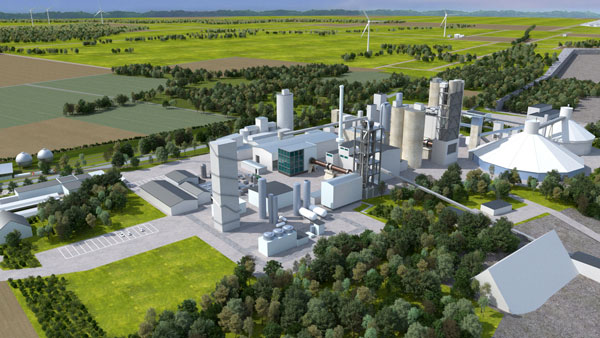Carbon emissions associated with concrete and cement production are well known and documented. However, the industry often fails to receive credit for its efforts to decarbonize manufacturing processes. Instead, attention and praise is often given to alternate materials.
Important innovations in concrete production are happening around the world, particularly in Europe.
Notable is GeZero, Heidelberg Materials’ fully decarbonized production facility at its Geseke plant in North Rhine-Westphalia, Germany. GeZero will showcase an entire Carbon Capture and Storage (CCS) solution, projected to capture 700,000 tonnes of CO₂ annually beginning in 2029.
The EU Innovation Fund, one of the world’s largest funding programs for innovative low-carbon technologies, has supported the GeZero CCS project with funding of €191 million.
“With GeZero, we will once again show how Heidelberg Materials’ pioneering spirit is paving the way for the decarbonization of our industry,” said Dr. Dominik von Achten, CEO of Heidelberg Materials. “We will be the first to realize a full CCS chain for the capture, transport and permanent storage of all CO₂ emissions from an inland location in Germany.”
The Germany facility is not alone. Swedish technology company Cemvision has achieved Industrial-scale production of green cement at their pilot project in Poland, reaching the equivalent of 4,000 tons annually.

Cemvision technology for the production of environmentally friendly cement is based entirely on recycled materials, primarily from the mining and steel industries. According to the company, the solution for fossil-free cement is to incorporate residual materials from other industries as high-value raw materials. That is resource-efficient, and also means that CO2 emissions are completely avoided, resulting in superior product properties compared to traditional Portland cement.
Other test projects are underway that attempt to eliminate Portland from the concrete manufacturing process.
In the United Kingdom, start-up company Material Evolution raised $19 million in 2021 to scale up production of what it claims to be Portland-free cement with an 85 per cent reduced carbon footprint. The proprietary technology replaces limestone with a chemical solution that creates a cement-like product through a fusion reaction that requires no heat at all.
“Since closing our seed round in September 2021, Material Evolution has achieved significant market traction from advanced off-take agreements amounting to over 35,000 tonnes of our product now entering the market after selling out our first year of production,” co-founder Sam Clark told media.
Elsewhere, Finish company Carbonaide says its process is ready for industrial production, using an automated system that operates at atmospheric pressure. When industrial side streams, such as steel industry slags, green liquor dregs and bio-ash concrete, are used in the process instead of normal cement, the result is concrete with a calculated carbon footprint of -60 kg per cubic metre, versus conventional concrete with approximately 250 to 300 kg per cubic metre.
“The method is compatible with the current manufacturing processes of concrete and can be used for manufacturing all precast concrete elements and products,” said Tapio Vehmas, leader of the Carbonaide team and senior scientist at VTT.
Developing countries like India are also embracing new processes for low carbon concrete.
“In India, the annual per capita cement consumption is almost equal to food consumption, emphasizing the importance of reducing CO2 emissions from the cement industry as demand for cement grows in the country,” write researchers Radhika Lalit and Swathi Shantha Raju.
The Bureau of Indian Standards recently released an exclusive Indian Standard (IS) code allowing the use of LC3, a limestone calcined clay cement. LC3 is a low-carbon alternative to ordinary Portland cement that first gained financial support from the Swiss Agency for Development and Cooperation in 2014.
The IS code provides comprehensive guidelines and specifications for the production, testing and usage of LC3 in concrete. With wider acceptance and adoption, the industrial scaling of low-carbon cement blends becomes possible.
The variety of developments for low carbon concrete around the world appears very encouraging.
John Bleasby is a Coldwater, Ont.-based freelance writer. Send comments and Inside Innovation column ideas to editor@dailycommercialnews.com.




Recent Comments